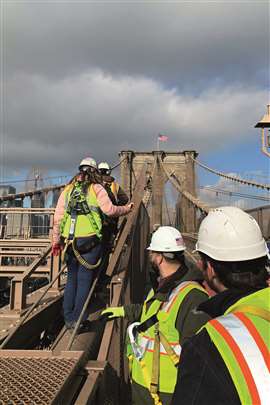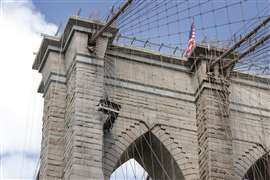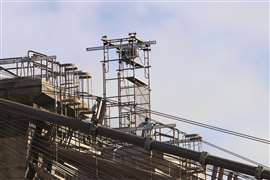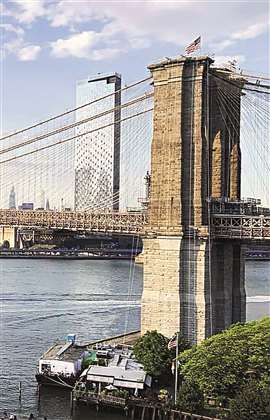Repairing an iconic connection in the Brooklyn Bridge
29 August 2023
 Due to the complexity of the project and lack of modern drawings, Rigging Consultants, PCS Engineering and Bee Access needed to tour the Brooklyn Bridge jobsite by walking the suspension cables to the top. (All photos by Mike Misiaszek, marketing manager, Bee Access)
Due to the complexity of the project and lack of modern drawings, Rigging Consultants, PCS Engineering and Bee Access needed to tour the Brooklyn Bridge jobsite by walking the suspension cables to the top. (All photos by Mike Misiaszek, marketing manager, Bee Access)
Since 1883, the iconic Brooklyn Bridge has stood majestically over New York City’s East River, connecting the two boroughs of Manhattan and Brooklyn. More than 150,000 vehicles and pedestrians utilize the bridge daily, crossing from one district to another, and because of such, the centerpiece of New York City’s skyline was in dire need of some TLC.
Enter the professionals
Pullman, a Maryland-based concrete repair specialist, was awarded the contract for the restoration project, which involved cleaning, inspecting and repairing the bridge while also bracing the granite slabs into the structure. To keep the bridge open for commuters, Pullman was interested in looking at options to provide 100 percent access to both towers – without the use of supported scaffolding.
So, in August 2021, Pullman reached out to New York-based suspended-scaffold specialist Rigging Consultants, who then contacted Bee Access and PCS Engineering, for help with a potential solution.
Known for their expertise in engineering and designing suspended access solutions, the team at Bee Access got to work.
Over the span of one month, Brian Andrews and the engineering team at Bee Access worked to determine the safest way to provide workers access to clean, inspect and repair the granite that comprises each tower of the Brooklyn Bridge.
Due to the complexity of the project and lack of modern drawings, a site visit was the first task at hand. After reviewing the project, Bee Access determined that the following would be required on each tower for the project to be successful, without the use of a crane or helicopter to transport material to the top of each tower:
- Material Hoist to raise all the equipment to the top of each tower: Beam secured to supported scaffolding with stairway access to the top of the tower BISOMAC Hoist attached to a trolley to raise/lower material Wire winder attached to a trolley to collect wire rope
- Monorail with two platforms for access to the interior of each side of the “arch” up to the apex: Monorail on each face of the arch Two platforms going through the arch and trolleys along each monorail
- Rigging beams secured directly to support beam(s): All beams to be secured directly to support beams to prevent the need for counterweights Special 90‐degree brackets to connect rigging beams(s) to support beam(s) Special beam stands to allow each beam to clear all the obstacles located at the top of each tower
- Platforms: (12) L‐Shaped Platforms (2) U‐Shaped Platforms (4) Straight Platforms (4) Straight Platforms under the arches
Next steps
Bee Access created a rigging layout plan for Rigging Consultants on how to provide complete access to each tower. After Pullman reviewed all the bids, the company felt most confident with Bee’s plan because of its attention to detail and ability to access all necessary areas.
 Photo 2: Closeup of one monorail running the length of the arch.
Photo 2: Closeup of one monorail running the length of the arch.
The plan was also the only one that didn’t use traditional counterweighted outriggers, drastically reducing the amount of labor required for setup and the amount of loading applied to the towers. Initially, each tower was to be serviced one at a time, but the design allowed for an inexpensive solution to service both at the same time to meet deadlines. Because Rigging Consultants was well under the $2 million budget, Pullman decided to purchase enough equipment to work on both the Manhattan and Brooklyn towers at the same time.
Providing support
The main obstacle that needed to be overcome was how the beams would be secured to the structure.
The idea of using two support beams mounted to the top of each tower was brought up. This allowed all personnel AND rigging a location to attach to while eliminating the need for counterweights, thus decreasing the load on the aging towers. However, the attachment points to the structure would be critical (especially on an older structure where drawings were not adequate).
Rigging Consultants worked directly with PCS Engineering to determine the location of each attachment point and verify the structural integrity of the system. With the approved attachment points and the dimensions taken during the site visit, Bee Access completed all the fabrication drawings for a total of 22 platforms, 2 support beams, 4 monorail beams and 27 rigging beams PER TOWER.
Each support beam was located as close to the center of the top of the tower as possible with special brackets keeping them away from the existing obstacles such as conduit, lightning rods, etc. In addition, each rigging beam had to be located at various heights to avoid railings and other barriers. Therefore, special brackets were designed to keep them at different heights and other brackets were designed to secure them to the support beams.
Monorails were designed to run parallel with the towers. Between each monorail was a straight platform attached to trolleys located on each monorail. This allowed access to the inside of the arches from the roadway to the apex of the arch (see Photo 2).
 Photo 3: Material hoist used to raise all the rigging equipment to the top of the tower.
Photo 3: Material hoist used to raise all the rigging equipment to the top of the tower.
The last challenge was the transportation of the rigging equipment to the top of each tower without the use of a crane or helicopter. Due to the height, a drum material hoist could not be used. Instead, a traction hoist with a passive wire winder to collect the wire rope was attached to a trolley with a specially designed bracket (see Photo 3).
Installation and utilization
The installation of the equipment was flawless. All the equipment arrived on time and undamaged. Each pallet was packaged and shipped for ease of transport from the receiving dock to the base of each tower. After carrying the material lifting equipment to the top of each tower by way of a supported scaffold staircase, it was set up and put into service. Each material traction hoist raised the support beams and their accessories first.
As more equipment was brought to the top, the main support beams were assembled and installed. After the support beams were installed, all rigging beam assemblies were built and put into service. Each material traction hoist raised all rigging equipment required for the project.
While the rigging was being assembled, personnel were assembling each platform at the base of the towers. Unlike the tower on the Brooklyn side of the river, the Manhattan Tower does not sit on dry land. Therefore, all equipment that was used from the roadway down was staged prior to use on a barge.
As soon as the rigging and the platforms were completed, workers were off and utilizing the equipment for the project.
The suspended scaffolding engineering, innovation and manufacturing speed of Bee Access, along with project installation expertise from Rigging Consultants, allowed for the Brooklyn Bridge restoration project to be on time and under budget – and win the Scaffold & Access Industry Association Suspended Scaffold Project of the Year Award.
 The bottom half of the tower can be seen fully clean, while the top half shows 50+ years of dirt and grime.
The bottom half of the tower can be seen fully clean, while the top half shows 50+ years of dirt and grime.
Project at a glance
The Brooklyn Bridge restoration project located in New York City encompassed the cleaning, inspection and repair of the granite that comprises each tower of the bridge. For workers to access the façade, it required standard suspended access equipment complemented with specially designed rigging accessories and special support beams secured to the existing tower structure. There were numerous challenges that Bee Access and Rigging Consultants faced, including:
- Providing a safe and complete access solution for workers to service each tower of the bridge
- Providing full access while keeping the bridge open for commuters
- All work to be completed within roughly 8 months
- Not overloading each tower with counterweights due to limited drawings
- No wire ropes, electric cables or lifelines hanging below the platform obstructing roadway and walkway traffic
- Transportation of all rigging equipment to the top of each tower without cranes or helicopters
The Brooklyn Bridge restoration project located in New York City encompassed the cleaning, inspection and repair of the granite slabs located on each tower of the bridge. For workers to access the façade, it required standard suspended access equipment complemented with specially designed rigging accessories and special support beams secured to the existing tower structure.
STAY CONNECTED



Receive the information you need when you need it through our world-leading magazines, newsletters and daily briefings.
CONNECT WITH THE TEAM







